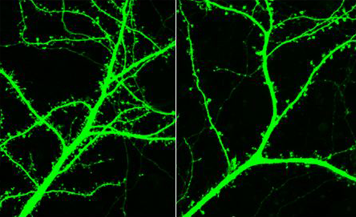 |
| Jacob Nordman, Ph.D |
 |
| A) Ionotropic receptor. B) Metabotropic receptor |
 |
| Growth cone structure |
The specific focus of Nordman's research is on the growth cone. It is a complex structure composed of three layers which guides axon development. The seven states it can be found in are initiation, formation, guidance, branching, turning, arrest, and retraction. Each growth cone state performs the function their name implies.
Mr. Nordman and his team have found that alpha 7 nAChR (nicotinic acetylcholine receptor) are enriched within growth cones. He research also focuses on a newly discovered cytoskeletal regulator termed G protein regulated inducer of neurite outgrowth 1 (GPRIN1). GPRIN1, also enriched in growth cones, scaffolds nAChRs within neurons. This brings us to his current study which investigates how alpha 7 nAChR regulates growth cone dynamics and axon targeting in the cortex and hippocampus during early brain development. The techniques being used include subcellular fractionation to isolate growth cones from newborn pups for proteomic analysis. They observed alpha 7 nAChR/GPC in the hippocampus under a microscope by highlighting it with anibodies fluorescent, a yellow signal.
When in development were
these proteins present? Nordman responded, the highest expression was during
the guidance period. It was most abundant in the soma/GC which makes sense
because that is where we expect the highest demand. How can we prove alpha
7/GPC interactions were present in the GC? Nordman stated neuron2a were
neuron-like cells. He used transfection,
planting DNA into a cell to produce protein; followed by immunoprecipation, removing many subunits of cells to focus on
relevant network he was measuring. By eliminating GP1 from scaffold to limit
interaction with GP1 and alpha 7, the weakened link suggested they are in fact
connected. To confirm active apha nAChR are present in the growth cone, Nordman
injected calcium sensors in the tissue grown in the petri dish. Using
PNU282987, an alpha 7 activator, a green fluorescent was present which
suggested alpha 7 was, in fact, in these cells.
While further investigating their
interactions, Nordman stated GPRIN1 is the master switch for alpha 7 signaling.
During a 12 hour test, he eliminated the expression of GPRIN1 which resulted in
shorter and less branching of neurons. This suggested GPRIN1 and alpha are
complementary and both are vital in growth cone function. To mediate alpha 7
growth, EB3 (end binding) comets, a microtubule capping protein, was used.
Using time lapse to give us real time changes of growth, EB3 moved at
approximately 3-5 microns every 10 seconds.
Mr. Nordman concluded that in
"active state", filopodia
projects in all directions. It commits to a direction through microtubules
invasion or collapse filopodia. Alpha 7 activation inhibits G proteins mediated
pathways involved in growth. The sum effect is microtubule capping and growth
cone collapse.
 |
| Fewer pathways cause symptoms of schizophrenia. This image shows neuron pathway (green strands) comparison between a healthy mouse (left) and one bredto express schizophrenia (right). |
Reference: http://krasnow.gmu.edu/kabbani/research-2/

No comments:
Post a Comment